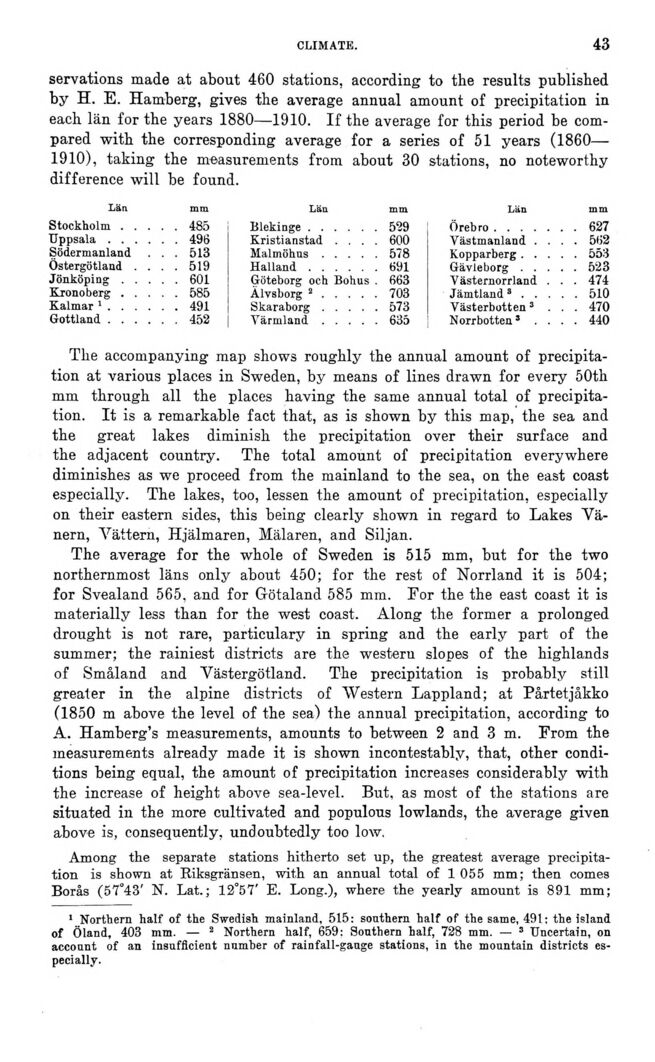
Full resolution (JPEG) - On this page / på denna sida - I. Physical Geography. Introd. by [G. Sundbärg] Gunnar Andersson - 3. Climate. By N. Ekholm

<< prev. page << föreg. sida << >> nästa sida >> next page >>
Below is the raw OCR text
from the above scanned image.
Do you see an error? Proofread the page now!
Här nedan syns maskintolkade texten från faksimilbilden ovan.
Ser du något fel? Korrekturläs sidan nu!
This page has never been proofread. / Denna sida har aldrig korrekturlästs.
CLIMATE.
43
servations made at about 460 stations, according to the results published
by H. E. Hamberg, gives the average annual amount of precipitation in
each län for the years 1880—1910. If the average for this period be
compared with the corresponding average for a series of 51 years (1860—
1910), taking the measurements from about 30 stations, no noteworthy
difference will be found.
Län mm Län mm Län mm
Stockholm.....485
Uppsala......496
Södermanland ... 513
Östergötland . . . . 519
Jönköping.....601
Kronoberg.....585
Kalmar 1......491
Gottland......452
Blekinge......529
Kristianstad .... 600
Malmöhus.....578
Halland......691
Göteborg och Bohus . 663
Älvsborg 2.....703
Skaraborg.....573
Värmland.....635
Örebro.......627
Västmanland .... 562
Kopparberg.....553
Gävleborg.....523
Västernorrland . . . 474
Jämtland3.....510
Västerbotten3 ... 470
Norrbotten3 .... 440
The accompanying map shows roughly the annual amount of
precipitation at various places in Sweden, by means of lines drawn for every 50th
mm through all the places having the same annual total of
precipitation. It is a remarkable fact that, as is shown by this map, the sea and
the great lakes diminish the precipitation over their surface and
the adjacent country. The total amount of precipitation everywhere
diminishes as we proceed from the mainland to the sea, on the east coast
especially. The lakes, too, lessen the amount of precipitation, especially
on their eastern sides, this being clearly shown in regard to Lakes
Vänern, Vättern, Hjälmaren, Mälaren, and Siljan.
The average for the whole of Sweden is 515 mm, but for the two
northernmost läns only about 450; for the rest of Norrland it is 504;
for Svealand 565, and for Götaland 585 mm. For the the east coast it is
materially less than for the west coast. Along the former a prolonged
drought is not rare, particulary in spring and the early part of the
summer; the rainiest districts are the westeru slopes of the highlands
of Småland and Västergötland. The precipitation is probably still
greater in the alpine districts of Western Lappland; at Pårtetjåkko
(1850 m above the level of the sea) the annual precipitation, according to
A. Hamberg’s measurements, amounts to between 2 and 3 m. From the
measurements already made it is shown incontestably, that, other
conditions being equal, the amount of precipitation increases considerably with
the increase of height above sea-level. But, as most of the stations are
situated in the more cultivated and populous lowlands, the average given
above is, consequently, undoubtedly too low.
Among the separate stations hitherto set up, the greatest average
precipitation is shown at Riksgränsen, with an annual total of 1 055 mm; then comes
Borås (57°43’ N. Lat.; 12°57’ E. Long.), where the yearly amount is 891 mm;
1 Northern half of the Swedish mainland, 515: southern half of the same, 491; the island
of Öland, 403 mm. — 2 Northern half, 659: Southern half, 728 mm. — 3 Uncertain, on
account of an insufficient number of rainfall-gauge stations, in the mountain districts es-
pecially.
<< prev. page << föreg. sida << >> nästa sida >> next page >>